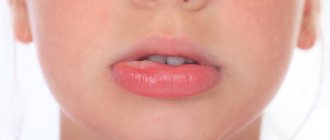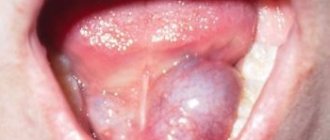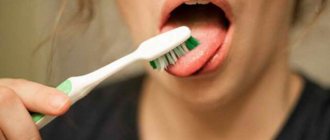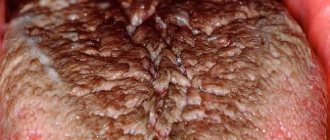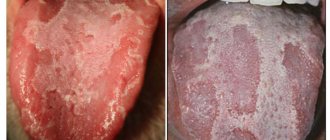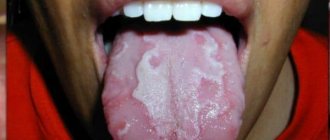What does a healthy tongue look like?
Keep in mind! An absolutely healthy tongue should look like this:
- pale pink color , a translucent coating is allowed or a little brighter than the main shade after waking up. Other tones indicate the development of certain diseases;
- uniform taste buds of small size;
- moderately wet - too dry tongue or increased salivation indicate pathology;
- absence of foreign unpleasant odors.
If gastritis is suspected, special attention should be paid to the central area of the tongue.
It is she who becomes covered with plaque in this disease.
How to properly clean plaque on your tongue
The optimal condition of the tongue can be maintained by regular cleansing using special toothbrush attachments, as well as a regular teaspoon. It is best if this spoon is small in size and made of silver. Delicate taste buds should not be injured by too sudden movements, otherwise the taste of foods will be altered for some time.
To soften plaque, you can rinse your mouth with a weak solution of soda or a pink solution of manganese. Begin cleansing from the base of the tongue, moving towards its tip.
After cleaning the tongue, the waste strips should be rinsed again with clean water. Taking good care of your health, timely examination, and careful study of symptoms different from the norm will help you avoid pathologies of the gastrointestinal tract and other systemic diseases.
Features of deposits in gastritis
Note! One of the characteristic symptoms of gastritis is an atypical coating on this sensory organ.
Its appearance depends on the form, stage and type of the disease. The level of secretion especially affects how deposits look.
Photo
The photo shows examples of raids:
Gastritis with low acidity
Low acidity of gastric juice significantly impairs the digestion process.
Even after eating a small portion of food, there is a feeling of heaviness in the stomach.
Often there is a belch with the smell of an eaten or rotten egg.
You should know! The main signs of a disease with low acidity:
- unpleasant taste in the mouth;
- frequent stomach upset;
- nausea;
- hair loss;
- weight loss;
- waviness of the nail plates.
The appearance of the tongue also changes . Patients with this pathology notice the following signs:
- excessive dryness;
- swelling;
- the lingual surface becomes glossy, the papillae are practically not visible.
In addition, there is a burning sensation in the mouth.
As for the plaque , it becomes grayish , quite dense in structure, with an extremely unpleasant odor .
Hyperacid gastritis
For your information! In the form of the disease with high acidity, the appearance of the tongue surface also changes.
The bottom line is that excessive production of hydrochloric acid is activated in the stomach, which causes irritation of the stomach walls, erosions and ulcers can form.
Hyperacid gastritis is characterized by the following symptoms on the surface of this sensory organ :
- the papillae become larger, the surface becomes rougher;
- belching sour, resulting in a burning sensation in the mouth;
- in general, normal humidity, but sometimes increased salivation appears.
With gastritis with high acidity, a burning sensation is felt on the tongue . This occurs due to the fact that acid is thrown into the esophagus.
At first, this process is accompanied by heartburn, after which bitterness appears in the mouth, then the person notices that there is a strong burning sensation in the mouth.
Stay up to date! A burning sensation in the mouth occurs not only with gastritis, but also with dental diseases.
Acute and chronic forms
Acute gastritis is accompanied by severe symptoms - severe abdominal pain, nausea, elevated body temperature.
A white-gray coating of dense texture appears on the tongue surface , covering the entire surface except the tip.
In the chronic form , a not very dense white coating forms on the surface .
During exacerbation, it becomes covered with white-gray spots.
It is always located in the central part of the tongue. After it is eliminated, it forms again after some time.
Important! If, in the chronic form of gastritis, bright red spots periodically appear on the tongue, this indicates that a stomach ulcer has begun to develop.
Diagnosis of gastritis by tongue
The type and condition of the white plaque will indicate in more detail the nature and stage of the problem
The type and condition of the white plaque will indicate in more detail the nature and stage of the problem. If it has a gray tint, a dense viscous consistency and covers the main part of the tongue (with the exception of the side parts), this indicates an acute form of gastritis. The chronic form of gastritis is characterized by a white coating that is located in spots over the entire surface. A pre-ulcerative condition provokes the appearance of a grayish tint with a reddish tint in places.
Diagnostics
The appearance of the tongue can tell about a person's health status. The plaque on it suggests what form of gastritis is developing.
But this is only during the initial examination. To establish an accurate diagnosis, a number of studies are required.
Based on their results, the doctor can accurately say why plaque appeared on the surface of the tongue, whether it is a consequence of gastritis or another pathology.
White plaque indicates a chronic form of the disease, white-gray plaque indicates acute or exacerbation of gastritis.
Tongue color for stomach cancer
In patients suffering from this disease, experts note the appearance of a grayish-white coating on the surface of the tongue. As a rule, the discoloration of the tongue is most noticeable at the root of the unpaired outgrowth, but in some cases the plaque can cover the entire muscle area.
Some gastroenterologists argue that the color of the tongue of a patient with stomach cancer may change depending on how advanced the disease is. At the extreme stages of cancer, it becomes completely white, and returning the organ to its normal appearance becomes quite problematic. In addition, this sign may be influenced by taking special medications that are prescribed to treat the tumor. In some cases, cases of darkening of the tip of the organ may be recorded.
The tongue with stomach cancer always changes its color. In the last stages of the disease, its surface sometimes becomes yellow-brown, which allows the doctor to diagnose cancer without any special tests. There are also special tables that can be used to determine the degree of advanced stomach cancer by the color of the patient’s tongue. Such diagnostics are carried out only by experienced gastroenterologists in a hospital setting.
The eyes are the mirror of the human soul, and the tongue can safely be called the mirror of health. The color of the tongue, shape and presence of plaque on it may indicate a particular pathology. Many diseases do not make themselves felt for a long time, and suddenly a detailed picture of clinical symptoms appears. Many doctors warn that the body lets you know about the disease almost immediately, and the most important thing is to notice and learn to recognize the disease. Direct help in determining health is, of course, language.
Anatomy of the tongue.
The tongue is a muscular organ that is covered with a mucous membrane. The organ performs many functions, participates in the formation of speech, determining the taste of food, mixes and helps form a bolus of food, and pushes it into the esophagus. Anatomically, the tongue is divided into two parts, the back part of the tongue is called the root, and the front part, which moves freely, is called the body. The upper surface, which looks like velvet, is called the dorsum of the tongue. The entire tongue is covered with papillae of 4 groups, which are responsible for determining taste.
What should a healthy tongue look like?
The tongue of a healthy person is pale pink in color with an even fold that runs along the tongue. The tongue is soft and does not cause any unpleasant sensations when moving. The papillae on the tongue are clearly visible and not smoothed. Depending on the time of year, a healthy tongue may have a little white coating; in summer, the coating is a little thicker, and the papillae of the mucous membrane are still visible through it. In winter, the plaque may take on a yellowish tint, and in the fall, the plaque becomes lighter and drier. In addition, the presence of a thin coating on the tongue may indicate a minor pathology that develops locally in the oral cavity, such as gum gingivitis, oral candidiasis and even caries. The thickening of plaque, in which it is already difficult to distinguish the back of the tongue, is a signal for action, and may indicate some diseases, including even chronic ones.
What does the color of the tongue say?
Many diseases can be identified by the color of the tongue, and each of them has its own characteristic color. In case of infectious diseases, such as measles or flu, the color of the tongue becomes burgundy; moreover, this color of the tongue indicates the presence of fever. A pale tongue indicates malnutrition, blood pathology - anemia, or heart failure. A purple tongue not only signals blood diseases, but also indicates diseases of the respiratory system. A yellow or gray tongue occurs in smokers, with jaundice, or indicates problems with the gastrointestinal tract. The black tongue, which frightens parents so much, and by the way for good reason, speaks of weakness of the liver and spleen, dysentery, serious viral infections and even abscesses. The color of the tongue indicates kidney disease. A bluish tint of the tongue occurs with poor blood circulation, scurvy and poisoning with heavy metals, especially mercury. A white tongue directly indicates a fungal infection or dehydration. Problems in the oral cavity can be judged by the presence of a dark brown tongue, which indicates bleeding in the oral cavity and in particular with periodontitis and gingivitis.
Causes of plaque on the tongue.
The main reason, of course, is poor oral hygiene. You need to take care not only of your teeth, but also of your tongue. For these reasons, special brushes have been produced that are suitable for cleaning teeth (bristles) and for the tongue; the reverse side of such a toothbrush has a ribbed surface. But not all children, due to their age, can use a toothbrush; finger toothbrushes with a ribbed working surface are also perfect for such purposes. But not only poor hygiene provokes the formation of plaque; various problems in the oral cavity of a dental nature can provoke the formation of plaque. At the first suspicion and the appearance of plaque on the tongue, you must first contact your dentist to rule out dental pathology. Disruption of the stomach or the entire gastrointestinal tract as a whole is also a provocateur in the formation of plaque. The accumulation of plaque on the tongue in children occurs for various reasons. The most common cause of plaque on the tongue in infants is oral candidiasis. In children of puberty, plaque can form due to hormonal changes and inflammatory diseases of the oral mucosa, the so-called juvenile gingivitis.
What does the color of plaque on the tongue indicate?
The color of plaque can indicate a particular disease, a particular problem with a certain organ or even a group of organs. But, to fully understand the process, it is still necessary to take into account the location of the plaque; only by adding these two components can we say with almost 100% probability that this is exactly this pathology. The coating on the tongue in most cases differs from the color of the tongue. The thicker the plaque, the more serious the pathological process. Plaque is the first sign of decreased immunity; based on the thickness of the coating on the tongue, one can conclude what type of immunity is being impaired (general or local).
How to get rid of plaque?
A white or white-gray coating on the tongue with an unpleasant odor from the oral cavity causes discomfort in a person.
It is worth noting! This condition is a favorable environment for the development of pathogenic microorganisms.
That is why it is necessary to carefully observe the rules of personal hygiene . It includes the following rules:
- You should clean your tongue and cheeks using auxiliary attachments or part of a toothbrush.
- It is necessary to clean carefully so as not to damage the papillae. This is done in the direction from the base to the tip of the tongue.
- If the coating on the surface is very dense, you need to use a softener . This could be a soda solution or other specialized products that are sold in pharmacies.
- brush your teeth 2 times a day . This will help get rid of bad breath. To neutralize it, you can also use special air fresheners.
- After brushing your teeth, you must rinse your mouth well.
- eliminate the bitter taste in your mouth by using mineral water, sage or chamomile decoction for rinsing.
- You should use mouthwash after every meal.
Reference! Alternative medicine will help to cope with the unpleasant feeling of bitterness in the mouth for the treatment of gastritis:
- Drink 1 glass of flax seed infusion every day It will eliminate not only bitterness, but also other unpleasant symptoms.
- A good way is corn silk infusion . To prepare it, take 1 tablespoon of crushed dried stigmas, pour 1 glass of boiling water, leave for 2-3 hours. Drink the finished product in small portions throughout the day.
Differentiation of plaque in gastritis from other diseases of the gastrointestinal tract
A thick, grayish coating is characteristic of dysentery. It is important to suspect the onset of a dangerous disease in time. To take action and prevent complications from occurring. Differential diagnosis by tongue of gastritis from other diseases and conditions:
- Desquamative glossitis - this type of inflammation of the tongue is characterized by such symptoms as red spots of complete absence of epithelium or several altered taste buds on the tongue, covered with a white coating.
A dense, grayish coating is characteristic of dysentery. In this case, the tongue looks cracked, and less saliva is produced than usual. - Desquamative glossitis - this type of inflammation of the tongue is characterized by such symptoms as red spots of complete absence of epithelium or several altered taste buds on the tongue, covered with a white coating.
- Galvanic stomatitis is a form of inflammation of the tongue that arises as a result of a reaction to metal prostheses, manifested by spots in the form of pimples, and subsequently by the appearance of erosions against a background of white plaque.
- Infectious diseases - sore throat, scarlet fever, diphtheria, HIV infection can cause the appearance of a white coating on the tongue, but almost all of these infections are accompanied by high fever and skin rashes.
- Diseases of the heart and blood vessels - plaque is located on the anterior third of the tongue.
- Kidney disease - plaque on the tongue is localized at the back along the edges.
- Endocrine disorders - under the plaques of white plaque there are ulcers and erosions.
- Anemia is not a coating on the tongue, but blanching of the entire surface of the organ. Diseases of the respiratory system are often indicated by the localization of white plaque on the front and along the edges of the tongue.
- Diseases of the salivary glands - the appearance of a white coating is accompanied by the appearance of an unpleasant odor.
- Diseases of the liver and gall bladder - the color of the plaque is not white, but has a yellowish or brown tint. A white coating on the tongue can be caused by the consumption of dairy products, as well as the proliferation of bacteria and fungi in those who abuse sweets. Unlike plaque during gastritis, such layers are easily removed and do not form further.
How various diseases affect the appearance of the tongue
The coating that appears on the tongue has different colors and shades, and its density varies. Such signs depend on the stage of the disease, the form of the pathology, the characteristics of the manifestation of the disease and the factor causing it. It is by this factor that it is customary to distinguish between the types of gastritis.
Click here - all materials about Gastritis
All portal materials about gastritis are above the link in the photo
. Differential diagnosis can determine the type of provocateur that causes the development of the disease. It is carried out to understand what stage the disease has reached, to choose methods of treatment, and to prescribe the necessary therapeutic diet.
The doctor can make a preliminary diagnosis based on the condition of the patient’s tongue, namely:
- according to the density of the plaque consistency (if the density is loose, it is easy to remove, it means that the inflammatory process is at the initial stage, for treatment it is recommended to use medications prescribed by a doctor, the therapeutic diet may have only minor restrictions);
- a dense, cracking plaque with a cheesy appearance can mean serious inflammation of the mucous membrane, especially if there is bad breath;
- in case of a viscous coating that occupies the entire tongue except the very tip, accompanied by dryness and burning, an exacerbation is diagnosed, requiring urgent measures for treatment;
- a clear sign of an exacerbation of an ulcer is considered to be a yellow or yellow-orange color of plaque with red spots, which may indicate the presence of stomach acid in the mouth;
- the tongue is grayish-white in color, the heterogeneous consistency of the plaque, in which plaques are visible in the form of individual islands of greater density, may mean that the disease has reached a chronic form caused by a bacterial infection;
- a grayish color of the tongue and a dense coating occurs in cases where inflammation of the mucous membrane is provoked by the use of certain medications; such gastritis is often called medicinal gastritis.
Monitoring the condition of the patient’s tongue is important not only for the attending physician, but also for the patient. Knowing the diagnostic criteria determined by the tongue, the patient will be able to assess his physical condition. Plaque in any form that appears on the tongue becomes a good reason to start taking medications prescribed by the doctor and strictly adhere to the prescribed diet, as well as seek qualified help if dangerous symptoms of a serious illness occur.
Prevention
To prevent the formation of pathological plaque on the tongue, you should undergo regular medical examinations. It is also recommended to limit the consumption of fried, fatty, spicy foods, sweets, fast food, and alcoholic beverages. With frequent consumption of strong tea, coffee, and regular smoking, a gray or dark coating often appears on the tongue. To prevent this from happening, you need to give up cigarettes and reduce the amount of coffee and tea. When dehydrated, a brown coating may appear on the tongue. Therefore, it is very important to maintain a drinking regime.
It is also recommended to follow the general rules for maintaining the health of the body - spend time walking in the fresh air, avoid stress and overwork if possible, do not overdo diets, be attentive to sleep schedules, nutrition and the quality of food consumed
Call our contact center at 8 (495) 230 03 09 and we will help you make an appointment with a specialist!
Oral hygiene and odor removal
With gastritis, not only plaque appears, but also an accompanying odor that is unpleasant both to those around you and to yourself. To get rid of both, you should follow a few simple rules:
- Teeth should be brushed at least twice a day;
- Learn to use dental floss; cleaning the space between your teeth should be done daily;
- You also need to clean your gums, and especially your tongue. In no case is this done with the main bristles of the toothbrush: this will only damage the mucous membrane;
- You can buy special fresheners and rinses, or rinse your mouth with decoctions of chamomile, mint, and sage. You can rinse both before and after cleaning. When buying a freshener, pay attention to the composition: chlorine dioxide will help cope with bacteria at the base of the tongue, which you cannot reach on your own;
- Eat “slow carbohydrates” to get rid of ketones and, accordingly, bad breath caused by their deficiency and the breakdown of fats. For gastritis, baked apples and bananas are ideal for this.
Based on all of the above, let’s summarize: the coating on the tongue itself is not dangerous, but the reasons for its appearance can be very diverse and serious. Maintain good oral hygiene, do not forget to visit specialists periodically and be healthy!
